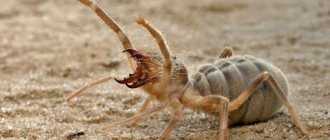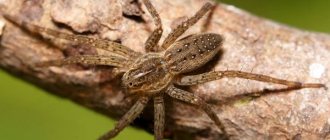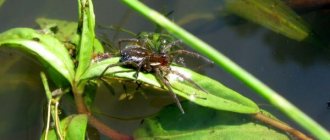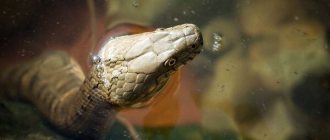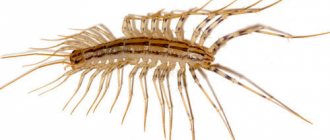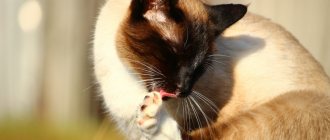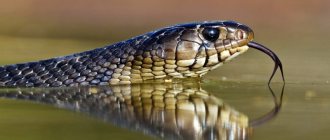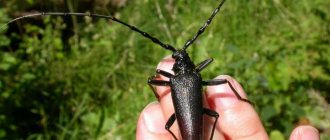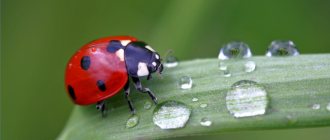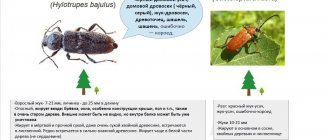Longhorned beetles are a fairly serious threat to wood, as it is part of their diet. Scientists know about more than 17 thousand representatives of this family. The most common is the black barbel. They are also called wood-boring beetles.
These insects damage plants that grow outside, as well as the wood from which houses and other buildings are made, as well as other wooden structures. They can turn wooden houses into dust, which you should not turn a blind eye to. At the first sign of the appearance of this pest, you should take care of how to get rid of it.
A little bit of biology
Longhorned beetles have fairly small sizes (from one to several tens of millimeters), a flat body and mustaches, which are the main organ of smell. The color of lumberjacks is usually brown or dirty gray; less commonly, the longhorn beetle is black. The photo allows you to examine the insect in more detail.
The larvae of the pest are characterized by particularly powerful jaws, thanks to which they can handle both hard wood and soft metal with a cable-type coating. However, the beetles do not eat the latter so readily, preferring wooden structures and stacked boards.
The female barbel lays her eggs (from 200 to 400 pieces) in recesses or cracks in the tree, and after 7-14 days the larvae are born, which instantly activate the process of destroying the tree.
It is worth emphasizing that it is almost impossible to immediately notice a tree disease, since the larvae lead a hidden lifestyle. So, you can understand that your wooden house has succumbed to the harmful effects of longhorned beetles only when the real results of their work (destroyed and loosening wood) are visible.
Professionals will help you fight the longhorned beetle
To treat the external surface of a wooden house with Clipper, you can invite a specialist with a cold or hot fog generator. This treatment allows you to evenly cover the entire treated surface with drops of insecticide, spending less time on it and saving on consumables.
Be wary of the proposal to treat your house against insect pests with a combination of Clipper and Bi-58. The poisonous drug Bi-58 is a bright blue liquid containing phosphoric acid esters, which leaves irremovable stains and an ineradicable chemical odor after its use. It is strictly forbidden to use this drug for treating interior spaces.
In the market for services offered by professionals for the destruction of wood-eating insects, the following areas deserve attention:
These methods have their advantages and disadvantages. They can only be used by specialists who have undergone special training, confirmed by the appropriate certificate.
Features
The woodcutter beetle has a number of characteristic features that distinguish this type of pest from many others. These include:
- Long mustache. The longhorned beetle has prominent whiskers that are 2-5 times longer than the insect itself.
- Slender and elongated body. The length of the body varies from 3 to 60 mm.
- Wings. Some species of woodcutter beetles can fly.
- Hair.
Tselinnik, Strigun, Kravchik
Large beetles, reaching 3.5 cm in length, prefer to live on untouched lands, but with the development of agriculture and human occupation, more and more land areas are settling in the vicinity of cultivated areas, which makes it easier for them to find food.
The head is flattened, large with a straight line connecting the forehead and clypeus, with a pair of cheek protrusions located at the edges of the eyes.
In front of the eyes there is a pair of hard antennae, at the ends of which there are brush-like thickenings. Males have fang-shaped hard processes on the jaw, which males use to win the right to mate. The mandibles, covered with short hairs, are hidden between the biting fangs. In females, the jaw processes are smoothly rounded and have no fangs.
Gardeners are annoyed by ants, Colorado potato beetles, mole crickets, May beetles, bedbugs, leafhoppers, wasps, cutworms, and locusts.
The Strigun has three pairs of tenacious and strong limbs, which are covered with stiff hairs, and there are claws at the ends of the paws.
The wings are not developed, this species does not fly, it has hard and short, fused elytra.
Did you know? Beetles are the most numerous family of insects, making up about 40% of all available individuals. Entomologists believe that there are more than five million species of beetles, although only 350 thousand have been studied to date.
Types of longhorned beetles
There are many longhorned beetles, depending on certain characteristics they are combined into groups. Thus, woodcutter beetles that specialize in the destruction of spruce, pine and fir trees include the short-whiskered beetle, the shiny-breasted beetle, the ribbed beetle and the rustic beetle. The second group: large and small ragii, black spruce longhorned beetle, and bronze pine pest. They gnaw the needles, thereby damaging the health of the tree, and then settle into its wood. It is the active activity of pest beetles of the second group that is the most common cause of the extinction of entire areas of forested areas. The third group of longhorned beetles are squeaky beetles. They prefer deciduous trees, including birch, aspen, and willow. These include the greater and lesser squeakers, marbled squeakers, musky barbels, spiny barbels, as well as certain species of sandpipers.
Fighting methods
Methods of combating the snow beetle require almost a creative approach, since the species is especially tenacious and prolific. Again, the tunnels of his burrows provide reliable cover.
Do chemicals help?
Insecticides for killing insects are mostly powerless; hiding in a hole, the pest will calmly wait out the treatment time, and then take over its own. It is possible to treat the soil with chemicals during propagation; according to the observations of farmers, this is the flowering period of apple trees.
Preparations can be used to treat the soil and burrow entrances, in the hope that this will somehow inhibit reproduction. Decis, Arrivo, Diazinon are used, and the foliage part of the plants is also treated. Even if the chemical treatment is successful, beetles escaping from the chemicals must be collected manually.
Important! When using insecticides, be careful in dosages; many drugs are not safe for both beneficial insects (bees) and humans.
greenery
What then?
Among the tips on how to poison the snow beetle, there is a method of pouring boiling water or a soap solution into the minks. Liquid is poured into holes in large quantities in the early morning or after sunset, when the beetles are probably in the hole. The method does not provide a 100% guarantee, but it can be used as an auxiliary tool.
On many forums you can find a recommendation to blow cheap polyurethane foam into holes, then simply dig out the beetles frozen in it. But here it’s worth thinking about: whether the components of the foam composition will be toxic to the soil, whether they will affect its composition.
One of the most popular and effective methods is regular sunflower oil. A solution of one hundred milliliters of oil and two liters of water (a plastic bottle can be used as a mixer and a working tank) is poured into the holes. The oil clogs the insect's respiratory organs, and in an attempt to escape, it crawls out of the hole. Breathing even on the surface is no longer restored and the insect dies.
In the fight against beetles, you need to constantly dig up the area, thus destroying the holes, you do not give the offspring a chance to survive.
The appearance of any insect pests in vegetable gardens and orchards is a threat to the crop, so it is always easier to prevent an insect attack than to fight their invasion. Timely digging and constant monitoring of plantings, taken preventive measures will preserve your harvest.
Where can I meet you?
The longhorned beetle can live and reproduce not only in various tree species, but also in shrubs and herbaceous plants. Longhorned females lay their eggs in a crack in tree bark, in depressions on branches, trunks or stems. Moreover, the pests make these cracks and gouges themselves.
Lumberjacks can “visit” you at your dacha, and the forestry industry can “boast” of such guests. In country houses, the objects of pest attack are furniture, boards and other wood products.
Distribution and habitats
They are distributed throughout the world, but the greatest species diversity is observed in the tropics, where 90% of the largest subfamilies of the true longhorned beetles (Cerambycinae) and Lamiinae (Lamiinae) are found.
They inhabit mainly forest areas, sometimes found as pests on wooden buildings.
Great spruce black beetle (Monochamus sutor)
What to do if you find a barbel at home?
If a mustachioed pest is found in the house, then an emergency response is necessary. Why? It’s just that if this insect gets into wood, which is the main material of your home, then it will not calm down until it eats it or, as they say, if it doesn’t eat it, it will spoil it, causing significant damage to the building as a whole.
The longhorned beetle is not dangerous to humans, but it can harm him by destroying his home. To ensure that your home doesn’t care about insects, the wood should be treated during the construction stage. There are several ways to protect wood. Fumigation using phosphine gas is considered the most effective and optimal. This method of wood processing is held in high esteem by both owners of wooden buildings and carpenters, who process each unit individually.
A longhorned beetle visited your house and settled in it - a problem whose solution consists of the following actions:
— Assess the degree of damage to the material. To do this, you need to take a screwdriver and try to pierce the tree. If the tool enters easily, then it is impossible to do without eliminating a separate section of the surface of the house or the structure of the wood material (rafters, frames, beams). This is direct evidence that your house, or certain elements of it, is being eaten by a longhorned beetle. See photo of the damaged wooden beam below.
Hard wood can be left, but subjected to special treatment.
— Prepare the structure for the processing process. Clean the surface of the wood using a brush with increased rigidity. In this case, the person involved in this process must have special equipment: a respirator, glasses.
— Remove the dust layer with a vacuum cleaner.
- Coat the wooden surface with insecticide. Irrigate even surfaces, but intensively moisten holes and cracks with the product.
— Close all door and window openings in the room for several hours (usually 34 hours).
— If the wooden surface is open, it must be systematically treated with hot drying oil. It is worth remembering that this option is far from the best, because when processed with such material, the original texture of the material is subject to change.
- Resort to the use of special products that penetrate deeply into the tree and are distinguished by a long period of preservation of their properties: “Antizhuk”, “Empire-20”, “Antishashelin”.
— Treat the tree with antiseptics once every 12 months. It is best to do this in the month of June.
— Treat affected areas of wood with carbon disulfide.
— Expose the affected tree to high temperatures (within 74 degrees). This can be done with a specially designed device, which will not be difficult to find and purchase.
Professional processing
Some processing methods are best left to professionals:
- Fumigation;
- Microwave disinsection.
Each method has its pros and cons.
Fumigation
Treatment of surfaces with chemicals in the form of gases or aerosols (hot, cold or dry fog). Fogging agents are now rarely used. They do not have such high permeability as gas; it is almost impossible to destroy the larvae inside the tree in this way.
Experts use fumigation using gases with phosphides (Phostoxin and Mactoxin). They are produced in tablet form. They decompose when exposed to air and release poisonous phosphine gas. Within a day, the substance can destroy all beetles, larvae and eggs. It will take about 2 days for the gas to decompose.
Advantage of fumigation:
- 100% destruction of all parasites;
- long-term effect after treatment (10 years);
- the ability to process a large area in a short time.
The disadvantage of the method is the high toxicity of the substances.
Learn about the rules and methods of first aid for a tick bite, as well as further treatment.
How to remove flies from an apartment? Effective methods of dealing with annoying insects are described on this page.
Go to the address https://parazitam-stop.com/nasekomye/klopy/effektivnye-sredstva.html and read about the reasons for the appearance of bedbugs in the apartment and how to destroy them.
Microwave disinsection
If the larvae and eggs are exposed to temperatures exceeding +55°C, they die. Special microwave installations have been created for this purpose. Microwave radiation is directed onto a specific surface, causing the molecules to vibrate and heat up. As a result of this effect, the parasites die. However, such radiation does not harm wood.
Advantages of the method:
- no need to evacuate people from home;
- you can quickly get rid of longhorned beetles;
- effective in all weather conditions;
The negative factor is that the work is painstaking. It is necessary to detect all the places where the parasite lives, this requires some experience. Specialists have special equipment for this – a stethoscope. They bug the house around the perimeter, each nest is treated with a radiator.
Longhorned beetle: how to get rid of it?
Special means of varied action will help you fight barbels in your own home. Which specific product to choose in this or that case is entirely up to you!
Conventionally, such funds can be divided into three groups:
- Contact. They manifest their effect directly upon contact with the longhorned beetle. Such products are not popular because their use can be harmful to human health.
- Intestinal. Such agents include sodium fluoride, zinc chloride and other components that exert their harmful effects on the insect through the intestines.
- Fumigants. These are gaseous and vaporous substances: sulfur dioxide, dichloroethane, etc.
Remember that solid wood, on the surface of which there are no cracks or other defects, is not of interest to pests. The longhorned beetle will live and reproduce only in cracks. Therefore, you can’t go wrong if you pour a special product into the grooves of the wood panel with a syringe, and then cover these holes with wood putty or ordinary plasticine.
Remember that it is very difficult to overcome barbels! It is much easier to resort to preventive methods, for example, using exclusively wood impregnated with fungicides for construction purposes.
Folk remedies
In addition to chemicals, folk remedies can be used to combat tree pests. Kerosene, turpentine and naphthalene effectively cope with the task of killing insects. They are mixed in a ratio of 1:4:1. This composition has a runny consistency, which is a deadly poison for insects.
This folk remedy is poured into holes made in wood or coated with tree trunks and affected surfaces. The beetles die from the fumes of the toxic mixture.
This is interesting!
The longhorned beetle family includes not only annoying wood pests, but also representatives of the Red Book of Russia. One of them is the relict longhorned beetle (woodcutter). Its habitat is the deciduous forest of the Far East. A distinctive feature is the body length, reaching 11 centimeters. Meeting such a beetle is a great success. The titan lumberjack, which has received the status of “the largest beetle on the planet,” and the long-legged harlequin, whose front limbs are longer than the length of the body, also need protection.
Continuation of life
Longhorn beetles breed in areas where there is silence and at altitude.
An excellent place - roof crossbars, tall trees. This is where mating takes place. During the mating season, females secrete a special liquid that is attractive to the “male half”. Insects are not averse to sexual games lasting up to half an hour. The fertilized individual is looking for a secluded place for a nest in order to lay a clutch in the future. There can be more than a hundred eggs in one place. Soon the adult dies. Her life on average lasts up to a month.
The male does not leave the female, he moves after her and waits for offspring. After two weeks, voracious larvae hatch. Everything that surrounds them serves as food for them.
Killer Cow
We have already mentioned enough species of black beetles . Ground beetles, whirligigs, some longhorned beetles and cockchafers may have this color. And even the firefighter beetle just described has extensive dark areas in its outfit.
But few of us have seen black ladybugs. However, they exist. This is a type of Asian ladybird. It may be black, decorated with red dots; it can also be yellow-orange with numerous blurry spots of black.
Such creatures are usually larger than other cow relatives, measuring about 7 mm. They are given the nickname killer cows because among insects they are fearsome and insatiable predators. We have already noticed that carnivorous beetle species tend to be beneficial.
And here we can assume that the more active the predator, the more positive its activity is for humans. The Americans thought the same thing about a quarter of a century ago. But they made a mistake by bringing the Asian ladybird to their lands, in the hope that it would become a successful destroyer of annoying midges and aphids.
The fact is that such cows, called “harlequins,” in addition to harmful insects, devour their fellow cows, other types of cows, which are very useful and valuable. Moreover, they damage grapes and berries. Now, having realized their mistake, they are fighting them, however, it is useless, because the dangerous species is spreading more and more widely.
European countries have already suffered from it, in particular Belgium, France, and Holland. In winter, Asian women climb into human homes, causing allergies in their owners. But no reliable means of combating killer cows have yet been invented.
How to prevent damage to building materials and finished products by tree beetles?
Compliance with the following rules will help prevent damage to building materials and finished products by the shawl beetle:
- Buy furniture and interior items made of wood from reliable trade organizations.
- Before purchasing building materials, check them for signs of pests. If possible, it is better to purchase heat-treated or autoclaved materials.
- Regularly (once every 1–2 years) treat wood with special antiseptic agents.
- From time to time, treat wood products with a mixture of turpentine, paraffin and creolin, taken in a ratio of 10:5:3.
- Avoid high humidity in the living area. To do this, it is recommended to ventilate it regularly.
- Elements affected by pests should be immediately thrown away or burned.
- Periodically inspect a wooden house and wooden interior items to promptly identify signs of wood beetle damage. This will be indicated by numerous passages in the wood, a specific sound heard at night, and a brownish or yellowish powder.
Features of lumberjacks
These insects are mostly harmless in themselves; they feed on plants, mainly of the woody variety.
But sometimes they look very menacing. The most striking feature is the long mobile whiskers, their size is 2 or even 5 times the length of the body. At the base of the antennae are the insect's eyes. The mustache is an organ of smell and touch. What all these beetles have in common is an elongated body structure, although, depending on the species, the shape itself can be wider at the sides and more elongated. The body structure of adult individuals can be divided into three main parts: head, chest and belly. The limbs are divided into 5 components - pelvis, trochanter, femur, tibia and tarsus.
They have 3 pairs of legs, hard chitinous elytra, and some have large jaws. The abdomen is soft, divided into segments, most often into five. Their head is round in shape and sometimes fits quite tightly into the prothorax.
Many longhorned beetles make sharp sounds, such as squeaking or grinding sounds. This occurs due to friction of the prothorax rib against the rough surface of the mesothorax, or friction of the thighs of the hind legs against the elytra. They make such sounds when there is a threat of attack from enemies. Most likely to scare them away.
Their coloring varies greatly. It consists of the color of chitinous wings and hairs on the body. The colors delight with their diversity. Light shades - creamy yellow, salad, lemon, pink.
Many people have encountered woodworms, which is why they know first-hand what the longhorned beetle looks like. Most of these insects have a body of medium size from 10 to 20 mm. But there are also giants. Thus, a titanium woodcutter can grow to almost 17 cm. Another giant can be called the large-toothed staghorn, which has similar dimensions.
Types of beetles
The body of the woodcutter beetle is often black or black-brown in color. But there are representatives whose body is white, pale yellow, gray-blue or green with a barely noticeable pearlescent or metallic tint. Below is a woodcutter beetle in the photo.
Beetles' habitat
Insects of this family are distinguished by a pattern of spots, multi-colored bands or stripes. A photo of an alpine longhorned beetle with an ornament on the elytra can be seen below.
Alpine barbel
Reproduction
The mating season of relict beetles begins with the arrival of spring. Males attract females using a special secretion. The fertilization process itself lasts about 30 minutes, after which the male guides the female to the place where eggs are laid. Up to 28 eggs are released per clutch. The trunks of fodder trees are used as a place so that the larva can fully feed and grow. Literally the next day, the male and female die.
In the larval stage, representatives of relict beetles make passages in the bark of a tree. They remain in the chosen place until they transform into an adult beetle. As a rule, the pupa of a relict beetle is formed in the summer. And its development lasts no more than a month, after which the beetles reach adult size.
Prevention measures
To prevent longhorned beetles from causing damage to your structure, you must:
- carry out a thorough inspection of the wood for the presence of holes made by insects;
- if damage is detected, use special protective equipment;
- keep the room dry, since excessive humidity is one of the favorable living conditions for insects;
- for preventive purposes, wooden surfaces must be periodically treated with special insecticidal agents;
- for construction, use material that is not infected with insects; this is easy to verify when the wood is cleared of bark;
- If wooden structures are heavily infested, they should be replaced with new elements.
By periodically carrying out these simple measures, you can protect your home from pests.
The longhorned beetle or woodcutter is a large and widespread family of beetles. A characteristic feature of this species is its huge mustache, several times longer than the body. They are classified as follows: arthropod insects, coleopterous longhorned beetles.
Entomological collectors are very fond of these beetles for their diversity in body size, shape of the elytra, various sculpted outgrowths, tubercles and spines on the elytra, and a wide range of colors. Some dried specimens cost around $1,000.
Also, a colony of woodcutter beetles is capable of destroying a significant area of the forest in a short time, which is why foresters exterminate them. For the above reasons, despite the large number of species and wide distribution throughout the planet, in the family of beetles there are individuals listed in the Red Book.
